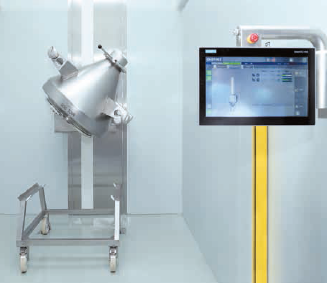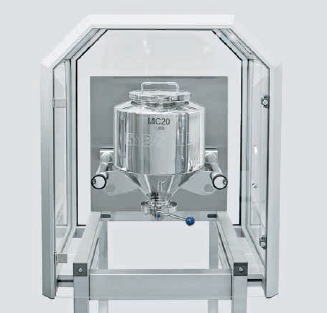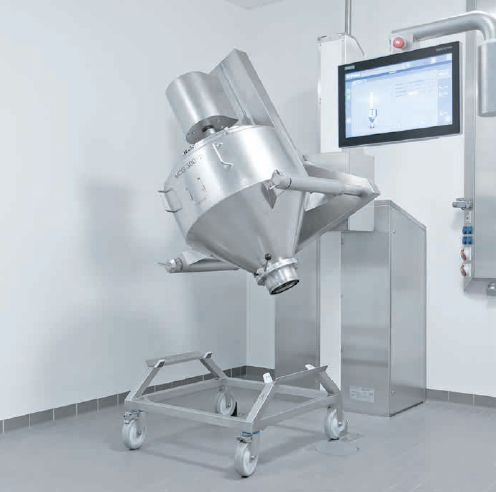The first L.B. Bohle container blender was produced in 1987 - since then, the German technology company has manufactured several thousand blenders. Every day, a wide variety of blending systems are used in production lines around the world.
Thanks to the innovative design, flexibility, and long service life of the machines,
L.B. Bohle has become the world market leader for pharmaceutical container blenders.
High flexibility and scalability
The blender product portfolio is characterized by a high degree of flexibility in design and production. This allows the blenders to be adapted to the customer's individual production requirements and daily specifications. All Bohle container blenders are used in all conceivable production scenarios in pharmaceutical, chemical and nutraceutical production.
Thanks to the patented mixing elements installed on the inside of the container lid, all blending systems allow a very homogeneous blending of the powder batch. Depending on the process, scalability up to 12,000 liters is possible.
As standard, the blending containers are supplied as exchangeable containers with a volume of up to 2,400 liters. Due to the innovative blending systems, each blending container can be used for effective blending between 20 and 85 percent of the total container volume for densities between 0.2–1.2 kg/dm³.
Another important design feature is the choice of pick-up systems: L.B. Bohle offers its customers five different pick-up systems.
Electronically monitored quick clamps
Versions with standard load arm and clamps are most frequently requested. Containers are docked using four electronically monitored quick clamps. Containers with a volume of up to 1,200 liters, which are mounted on an undercarriage, can be adapted to the blender without the need for additional lifting equipment. Optionally, a chopper can be installed in the container lid can be used. The drive of this chopper is integrated into the load arm of the blender.
Another blender design is a version where the system can be swiveled around its vertical axis. This allows for optimum adaptation to the customer´s requirements. Long service life and extremely low maintenance requirements are other advantages of this design.
In another popular version of the pharmaceutical blender, the container with its adapter tubes is slid onto two receiving mandrels. Two screws on the front side grip the container and prevent it from slipping. As with other Bohle mixing systems, the container is lifted through the mixing systems and rotated.
Ideal solution for automated container pick-up
 In the third version of L.B. Bohle blending systems, the load arm is equipped with eccentric clamps. Containers are picked up with tines and automatically clamped by eccentric movement in the pick-up tubes, the so-called adapter tubes. This is a very safe pick-up method that is ideal for automated container pick-up, e.g. on a guide rail. If the containers are equipped with a circumferential frame, they can also be picked up and set down in an inverted position. This model is also available in a swivel version that can be rotated around the vertical axis.
In the third version of L.B. Bohle blending systems, the load arm is equipped with eccentric clamps. Containers are picked up with tines and automatically clamped by eccentric movement in the pick-up tubes, the so-called adapter tubes. This is a very safe pick-up method that is ideal for automated container pick-up, e.g. on a guide rail. If the containers are equipped with a circumferential frame, they can also be picked up and set down in an inverted position. This model is also available in a swivel version that can be rotated around the vertical axis.
A fourth version is equipped with a load support with power clamps. These apply pressure to the lower frame of the upright, ensuring that the container is tightly clamped to the load support.
They can be adjusted either via the upright or via support rails on the machine body. Load handling can be either straight or at an angle of up to 30 degrees to accommodate existing blending processes. This system has proven itself in many years of use on Bohle's SFM mixers.
The fifth version is a system where the load arm is equipped with hydraulic clamps. The containers are hydraulically clamped between the fixed and moving parts of the load arm. Various sensors with appropriate controls ensure safe operation of the system. The load handling can be adapted to different types of containers. It is also possible to pick up containers at an angle of 30 degrees. In combination with a lifting unit, the design is particularly flexible and, above all, has a small footprint.
All of these five versions of L.B. Bohle mixing systems demonstrate the flexibility of the design, regardless of the type of container used in production.
Conclusion: Bohle blenders can handle round or square containers with excellent blending results.
Laboratory Blenders for Research and Development
 L.B. Bohle has developed the LM 40 laboratory blender specifically for research and development applications, offering high flexibility, mobility, scalability and rapid discharge.
L.B. Bohle has developed the LM 40 laboratory blender specifically for research and development applications, offering high flexibility, mobility, scalability and rapid discharge.
The modern laboratory blenders are designed for optimal homogeneous blending of pharmaceutical solids. The excellent efficiency of the LM 40 is attributed to the innovative proprietary L.B. Bohle countercurrent process principle. This unique method also protects the operator and the product from contamination during processing.
The state-of-the-art LM 40 laboratory blender is optimized for R&D applications and meets all current GMP requirements regarding design, operation, and control.
It has a compact flexible design. The blending technology is powered through an AC motor located inside the machine housing for maximum efficiency. The control panel is also integrated into the machine housing for easy access.
Equipped with adapter tubes, the containers are easily picked up by the laboratory blender's integrated forklift pick-up system. Flexibility allows square containers, drums, double-cone containers, V-shells and other specialty containers to be used for blending. In addition, the optional mobile lifter ensures that all containers and bowls can be easily removed.
Compact, single-axis rotation and a small footprint make this laboratory blender ideal for space-constrained environments.
Scalable production output from 5 to 12,000 liters
The LM 40 laboratory blender allows easy scale-up to the required production size, providing scalable results from 5 to 12,000 litres. Blending results can be easily transferred to a production scale blender.


